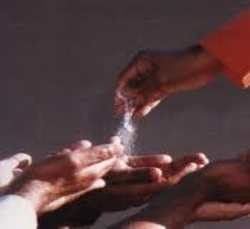In Addition
Vol 14 अंक 1
January / February 2023
Health Tips
Prevent and combat Lung diseases
“These days pollution affects everything: the air we breathe, the water we drink, the sounds that slowly dull the ears, and the food we consume. Because of this all-round pollution, man's health is affected. Apart from this, man's mind also gets polluted making him susceptible to diseases. Man should make an earnest endeavour to lead a serene and pure life.… An occasional cough helps to strengthen the lungs and clear them of extraneous matter, but fits of coughing are signs of positive illness”… Sathya Sai Baba1,2
1. Prelude
Health articles in earlier newsletters3 have comprehensively covered both functions and disorders of the upper respiratory tract. In this article, we deal with the lower respiratory tract and its disorders.
2. Lower respiratory system
2.1 Structure: The triangular lungs, somewhat resembling the ears of an elephant, are the only organs that float in the body. They reside in the thoracic cavity (chest), along with the heart and other 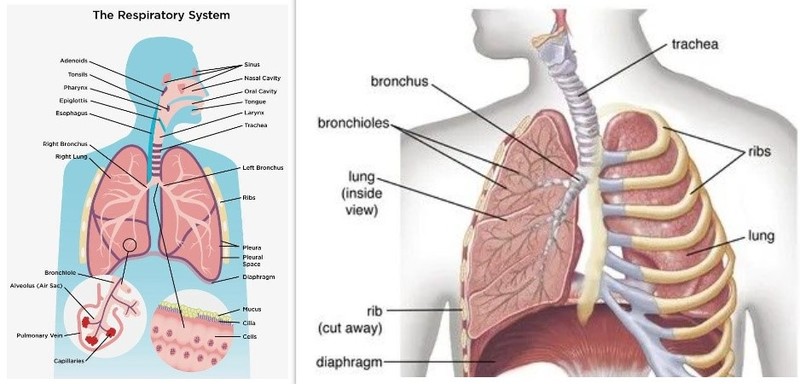 blood vessels, covered and protected by the pleural tissue. The structure and size of the lungs are such to accommodate the heart between the lungs. The rib cage, supporting and protecting the lungs and the heart, rests on the diaphragm, which separates the thoracic cavity from the abdominal cavity.4-6
blood vessels, covered and protected by the pleural tissue. The structure and size of the lungs are such to accommodate the heart between the lungs. The rib cage, supporting and protecting the lungs and the heart, rests on the diaphragm, which separates the thoracic cavity from the abdominal cavity.4-6
The lung representing the lower respiratory tract is like an upside-down tree which allows us to breathe. The trunk is the windpipe or “trachea” and the branches are the two “bronchi” (bronchial tubes/airways) with their minute sub-branches, “bronchioles”. The leaves are the air sacs or “alveoli” (300 to 500 million in an adult) at the terminus of each bronchi in the bottom.7
2.2 Function: When we breathe, oxygenated air from the upper respiratory tract passes into the trachea and through the bronchi into the lungs. Oxygen (O2) diffuses through the alveoli into the network of pulmonary capillaries surrounding them and reaches the heart from where it is pumped through the bloodstream to the tissues and organs that allow us to walk, talk, and move. Carbon dioxide (CO2 ) from the deoxygenated blood is expelled through the trachea during exhalation. This process takes place 12 to 20 times per minute; alveoli play a crucial role in this gas exchange. During normal breathing, muscles around the airways are relaxed, letting air move easily and quietly. Mucus produced in the trachea and bronchi keeps the air passages moist and protected. “Cilia”, small hair-like structures on the inside of bronchi, move mucus out of the airways and keep them clean. Cigarette smoking stops cilia from working properly and can change the pinkish-grey colour of healthy lungs to a darker grey with black spots indicating damage.5,6
3. Some major lung diseases
3.1 Bronchial asthma (or asthma): In this condition airways become inflamed, swollen, and narrow with thick mucus clogging them. As the surrounding muscles tighten, every breath creates a 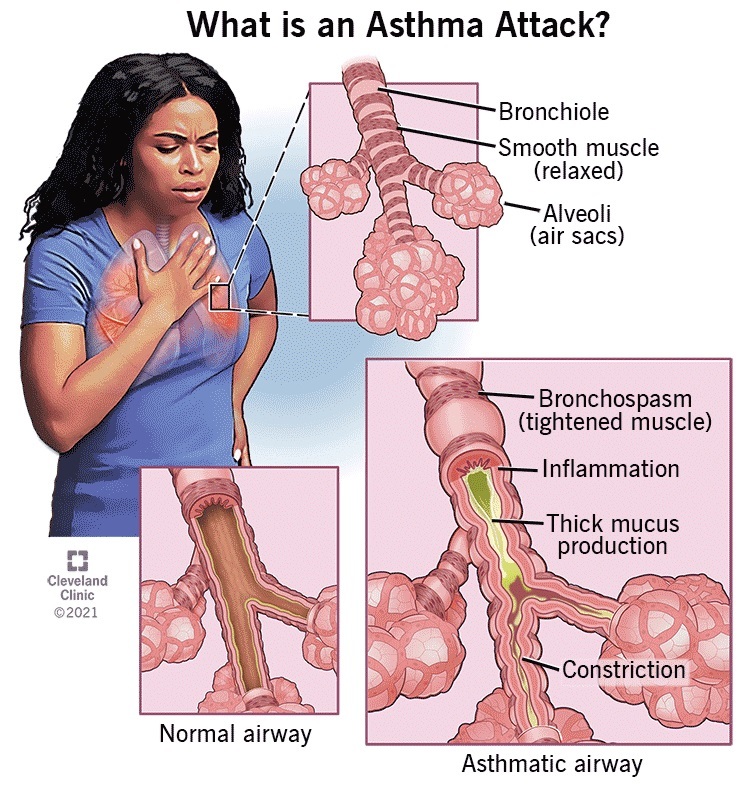 whistling or rattling sound called wheezing. Other symptoms are chest tightness, pain, or pressure, shortness of breath (dyspnoea), and coughing, especially at night; not all symptoms appear in every flare-up or attack. Childhood asthma often begins before the age of five, around 50% of children outgrow it upon reaching adolescence.8
whistling or rattling sound called wheezing. Other symptoms are chest tightness, pain, or pressure, shortness of breath (dyspnoea), and coughing, especially at night; not all symptoms appear in every flare-up or attack. Childhood asthma often begins before the age of five, around 50% of children outgrow it upon reaching adolescence.8
Causes: Can be an allergy to mould in damp places, household pests like cockroaches or mice, pet dander, house dust mites (invisible bugs) found on rugs, carpets, and stuffed furniture, or dust from other sources like flour or wood and exposure to environmental allergens such as toxins, 2nd hand smoke, fumes, strong smells, chemicals or pollen, which can act as triggers. Among non-allergic factors are exercise, weather or genetic susceptibility.8,9
Respiratory infection (eg, cold or flu) can exacerbate asthma symptoms, especially at night when lung function is naturally less, more so if the symptoms are poorly controlled during the day. Furthermore, pressure on the chest or lungs depending on the way you sleep, whether on your back or side or even face down, can make a difference, as well as late evening exposure to air (too cold or too hot); side effects of medication can also worsen the symptoms at night. 8,9
Caution: Asthma can become a major problem hindering day-to-day activities, sometimes becoming even life-threatening. If impossible to avoid the triggers, know your warning signs of an attack and be prepared to counter it. Seek medical help if chest pain or pressure is present along with bluish or pale fingernails, lips or gums, pale sweaty face, coughing that won’t stop, severe wheezing, very rapid breathing or difficulty talking and Rescue remedy or inhaler is ineffective. Though not an infection, asthma can increase the risk of developing bronchitis.8,9
3.2 Acute bronchitis (chest cold) is an infection inflaming the trachea and bronchi, filling both with mucus, usually viral but occasionally bacterial and sometimes caused by breathed-in physical or chemical irritants. It lasts for a week to 10 days and goes away on its own. The main symptom is a persistent productive cough which may linger for 2 to 3 weeks or more, with or without white, green, or yellow mucus. Other symptoms include chill, mild fever with headache and body ache, fatigue, soreness or tightness in the chest, runny nose, and sore throat.10,11
 Caution: A cough that lasts for more than 3 weeks or produces blood, fever greater than 102°F or that lasts for more than 5 days with shortness of breath or wheezing are indicators of a serious situation. Rarely, pneumonia may develop.10,11
Caution: A cough that lasts for more than 3 weeks or produces blood, fever greater than 102°F or that lasts for more than 5 days with shortness of breath or wheezing are indicators of a serious situation. Rarely, pneumonia may develop.10,11
3.3 Chronic bronchitis: A cough with mucus during most days of the month for three months a year, lasting two years in a row indicates chronic bronchitis. Cilia become damaged and cannot help clear the mucus, often due to smoking. This may lead to chronic obstructive pulmonary disease (COPD).10,12
3.4 Pneumonia is inflammation of the lungs with fluid in the alveoli obstructing breathing. Mild to life-threatening, this acute 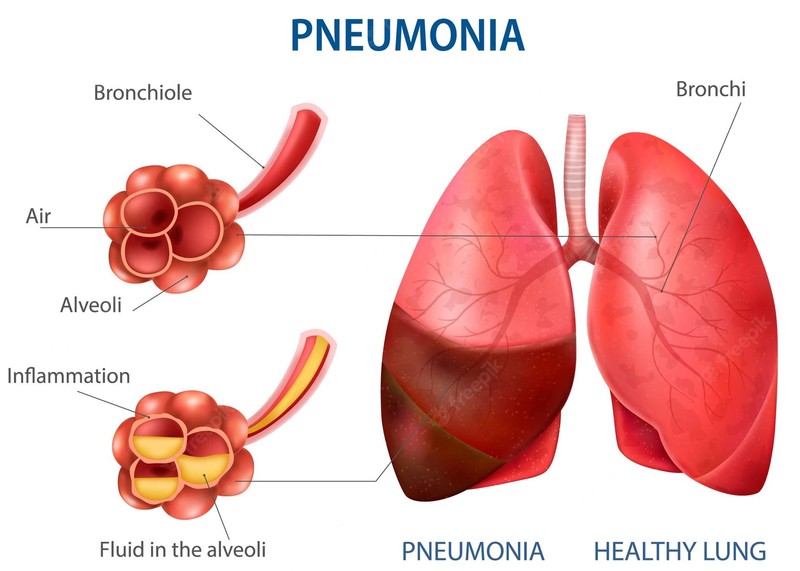 infection is generally caused by a virus or bacteria, rarely by fungi or other organisms. Usual symptoms are fever and cough with yellow, green, or bloody mucus; also accompanied by chest pain, shaking chills, shortness of breath, sweating, low energy, and extreme tiredness. Viral pneumonia with flu-like symptoms in the beginning and wheezing may invariably lead to the more common and severe bacterial pneumonia requiring special care. Symptoms then might be delirium due to very high fever up to 105°F, profuse sweating, rapid breathing and pulse, and bluish lips and nailbeds. Vulnerable are those below the age of two or above 65 or those with a medical condition, weakened immune system, or smokers.13,14
infection is generally caused by a virus or bacteria, rarely by fungi or other organisms. Usual symptoms are fever and cough with yellow, green, or bloody mucus; also accompanied by chest pain, shaking chills, shortness of breath, sweating, low energy, and extreme tiredness. Viral pneumonia with flu-like symptoms in the beginning and wheezing may invariably lead to the more common and severe bacterial pneumonia requiring special care. Symptoms then might be delirium due to very high fever up to 105°F, profuse sweating, rapid breathing and pulse, and bluish lips and nailbeds. Vulnerable are those below the age of two or above 65 or those with a medical condition, weakened immune system, or smokers.13,14
3.5 Emphysema is a chronic lung condition where the walls of alveoli break down making it hard to get a full breath. At its mildest, in stage 1, lungs operate at 80% characterised by gradual 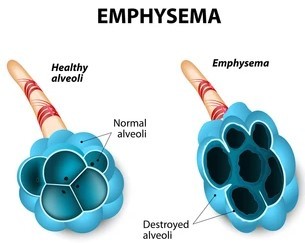 shortness of breath and fatigue, with productive cough and wheezing. As it progresses to stage 4, the lungs operate at less than 30%. Men in the age range of 50 to 70 are most affected, mainly due to many years of smoking, exposure to air pollutants or frequent respiratory infections; quite rarely, due to genetic deficiency of AAT (alpha-1 antitrypsin) - an enzyme that helps protect lungs from the damaging effects of inflammation.15
shortness of breath and fatigue, with productive cough and wheezing. As it progresses to stage 4, the lungs operate at less than 30%. Men in the age range of 50 to 70 are most affected, mainly due to many years of smoking, exposure to air pollutants or frequent respiratory infections; quite rarely, due to genetic deficiency of AAT (alpha-1 antitrypsin) - an enzyme that helps protect lungs from the damaging effects of inflammation.15
3.6 COPD covers a range of progressive lung diseases including chronic bronchitis and emphysema. Though preventable and treatable, severe flare-ups can be life-threatening. It is a leading cause of disability and death in the USA due to active smoking or prolonged exposure to smoke, harmful gases, and airborne particles from pollutants. Another risk factor is childhood respiratory infections. Early warning signs of COPD (stage 1) are generally overlooked: feeling breathless with light exercises, walking up the stairs and early morning phlegmy cough. As it advances (stages 2 & 3) shortness of breath will be evident even during daily activities; such a patient is prone to bronchitis and pneumonia. Stage 4 limits mobility and needs supplemental O2. All COPD cases should get a blood test done for AAT deficiency.16
3.7 Tuberculosis (TB) is a bacterial infection that usually affects the lungs (pulmonary TB); sometimes the brain, spine or kidneys. It could be dormant and become active when immune system is 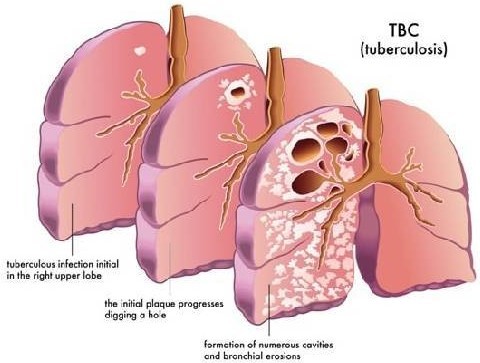 weak. Though preventable and curable, it is fatal if not treated. Symptoms are bad cough for more than two weeks, with blood or sputum, chest pain, fatigue, loss of appetite and weight loss, in addition to fever, chills and night sweats. Though infectious and transmitted through air due to cough, sneeze, or spit of a TB patient, it is not easily detected as symptoms remain mild for many months. Screening is done through Mantoux tuberculin skin test (TST) and blood test followed by sputum test and chest X-ray or CT scan to determine infection. Ending the TB epidemic by 2030 is one of the health targets of UN sustainable development goals.17,18
weak. Though preventable and curable, it is fatal if not treated. Symptoms are bad cough for more than two weeks, with blood or sputum, chest pain, fatigue, loss of appetite and weight loss, in addition to fever, chills and night sweats. Though infectious and transmitted through air due to cough, sneeze, or spit of a TB patient, it is not easily detected as symptoms remain mild for many months. Screening is done through Mantoux tuberculin skin test (TST) and blood test followed by sputum test and chest X-ray or CT scan to determine infection. Ending the TB epidemic by 2030 is one of the health targets of UN sustainable development goals.17,18
4. Other Respiratory disorders
4.1 Dyspnoea: Chest tightness, shortness of breath, or laboured breathing can happen due to anxiety, overexertion, major temperature changes, or high altitude. If resulting from inactivity, exercise often improves it. Acute or chronic dyspnoea is normally caused by heart or lung diseases.19,20
4.2 Pleurisy involves inflammation of the pleura indicated by sharp and stabbing chest pain which worsens while breathing, coughing, or sneezing, along with dyspnoea, fever, and fatigue. Causes are viral or bacterial infection, lung ailments (most commonly pneumonia) or autoimmune diseases like lupus or rheumatoid arthritis.21,22
4.3 Pulmonary fibrosis (PF) is a family of serious lung diseases. Though rare, it is a progressive and terminal disease. The thin walls of the alveoli scar and thicken over a period of time, lose elasticity and get damaged, making breathing and simple routine task very difficult. Rounded and swollen fingertips, fatigue, and weight loss are other symptoms. Usually affects those above the age of 70. It is important to be treated and to stay active and eat well for relief. 23,24
4.4 Pulmonary hypertension (PH) is high blood pressure in the pulmonary arteries, a complication of a heart or lung disease. Shortness of breath is one of the first symptoms.25
4.5 Pulmonary oedema is an abnormal build-up of fluid in the lungs, its main cause being congestive heart failure. It is not, as in pneumonia, due to infection.26
4.6 Lung cancer is uncontrolled cell division that starts in the lungs (primary) or spreads to the lungs from other organs (secondary). The first signs could be a cough or pneumonia that keeps recurring even after treatment. Smoking is a leading risk factor. Pleural mesothelioma affects the tissue surrounding the lungs and exhibits unusual lumps of tissue under the skin of the chest.27-29
5. Tips to prevent and combat respiratory disease
Most lung diseases can be prevented by avoiding exposure to irritants and triggers, increasing lung capacity by activity and exercise, good hygiene, rest and proper diet. For details on preventive measures and home remedies, refer to newsletters.3,30 Incidentally, it is possible to lead a normal life with only one healthy lung.
- Sathya Sai Speaks on “Food, the Heart, and the Mind, 21 Jan 1994: https://www.sssbpt.info/ssspeaks/volume27/sss27-03.pdf
- Sathya Sai Speaks on “Good Health and Goodness, 30 Sept 1981: https://www.sssbpt.info/ssspeaks/volume15/sss15-21.pdf
- Vibrionics Newsletter: Combating Common Cold vol 9 #6, Nov-Dec 2018; Prevent and counter Cough vol 10 #2 Mar-Apr 2019; Taking care of Nose and Throat vol 12 #4, July-Aug 2021;
- Profile of respiratory system: https://www.lung.ca/lung-health/lung-info/respiratory-system
- Lungs: Structure & Function: https://my.clevelandclinic.org/health/body/8960-lungs#
- Respiratory system: https://www.visiblebody.com/learn/respiratory/lower-respiratory-system
- Lung like a tree: https://my.clevelandclinic.org/health/diseases/8709-chronic-obstructive-pulmonary-disease-copd
- Asthma: https://my.clevelandclinic.org/health/diseases/6424-asthma
- Causes & Triggers of Asthma: https://www.cdc.gov/asthma/faqs.htm
- Bronchitis: https://my.clevelandclinic.org/health/diseases/3993-bronchitis
- Acute bronchitis: https://www.hopkinsmedicine.org/health/conditions-and-diseases/acute-bronchitis
- Chronic bronchitis: https://www.hopkinsmedicine.org/health/conditions-and-diseases/chronic-bronchitis
- Pneumonia: https://my.clevelandclinic.org/health/diseases/4471-pneumonia
- https://www.lung.org/lung-health-diseases/lung-disease-lookup/pneumonia/symptoms-and-diagnosis
- Emphysema: https://my.clevelandclinic.org/health/diseases/9370-emphysema
- COPD: https://my.clevelandclinic.org/health/diseases/8709-chronic-obstructive-pulmonary-disease-copd
- Tuberculosis: https://my.clevelandclinic.org/health/diseases/11301-tuberculosis
- https://www.who.int/news-room/fact-sheets/detail/tuberculosis
- Dyspnoea: https://www.medicalnewstoday.com/articles/314963#causes
- https://my.clevelandclinic.org/health/symptoms/16942-dyspnea
- Pleurisy: https://my.clevelandclinic.org/health/diseases/21172-pleurisy
- https://www.hopkinsmedicine.org/health/conditions-and-diseases/pleurisy
- PF: https://my.clevelandclinic.org/health/diseases/10959-pulmonary-fibrosis
- https://www.nhs.uk/conditions/idiopathic-pulmonary-fibrosis/
- PH: https://my.clevelandclinic.org/health/diseases/6530-pulmonary-hypertension-ph
- Pulmonary edema: https://my.clevelandclinic.org/health/diseases/24218-pulmonary-edema
- Lung cancer: https://my.clevelandclinic.org/health/diseases/4375-lung-cancer
- https://www.nhs.uk/conditions/lung-cancer/
- Pleural mesothelioma: https://www.mayoclinic.org/diseases-conditions/mesothelioma/symptoms-causes/syc-20375022
- Vibrionics Newsletter: Breath vol 2 #3 May 2011; Asthma and Diet vol 4 #4 July-Aug 2013; Breathe right with awareness vol 10 #5 Sept-Oct 201
2. Workshops
1. AVP workshop: virtual 2-18 Nov followed by face-to-face at Puttaparthi 25-27 Nov 2022
Four participants from India qualified as AVPs during the face-to-face workshop after a virtual practical workshop in Nov 2022. “Start your practice with 100% rock-solid unwavering faith and create positive vibes in your patients”. These inspiring words of Dr Aggarwal in his valedictory address kindled the seva spirit of the new AVPs who vowed to do their best. He cautioned them, “feel neither elated when many patients get cured & praise you, nor distressed when results are not to your satisfaction, as both these feed the ego.”
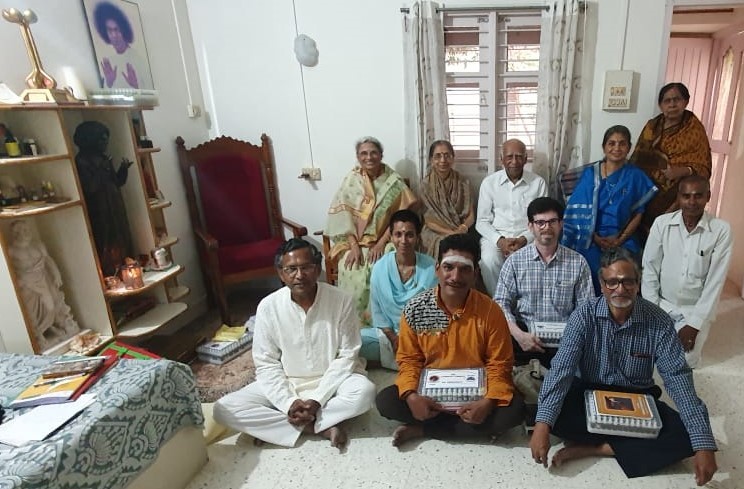
2. Virtual Follow-up course for SVPs, 8-9 Dec 2022
Six SVPs who qualified in March 2022 presented the case histories of their patients and their experience of using the cards and the SRHVP. The highlight of the course was guidance by Dr Aggarwal on nosodes, miasms, Bach remedies, and broadcasting. On successful completion of their course, all six SVPs received their certificates and can now formally start treatment with miasms, and start broadcasting the remedies using their SRHVP machines.
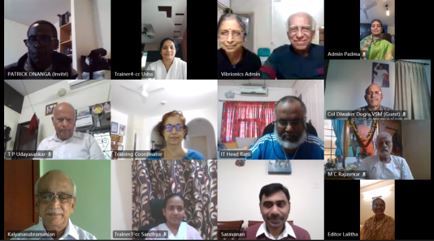
3. AP Telugu workshop 29-30 Nov & 1 Dec 2022 Puttaparthi
The second AP workshop in Telugu was held for four participants from the state of Andhra Pradesh, India. Our senior teachers conducted the classes and practical sessions at Prashanti Nilayam. The zeal and enthusiasm of the participants were remarkable. At the end of the three-day workshop, they felt even more inspired after listening to the dynamic and encouraging words of wisdom by Dr Aggarwal.
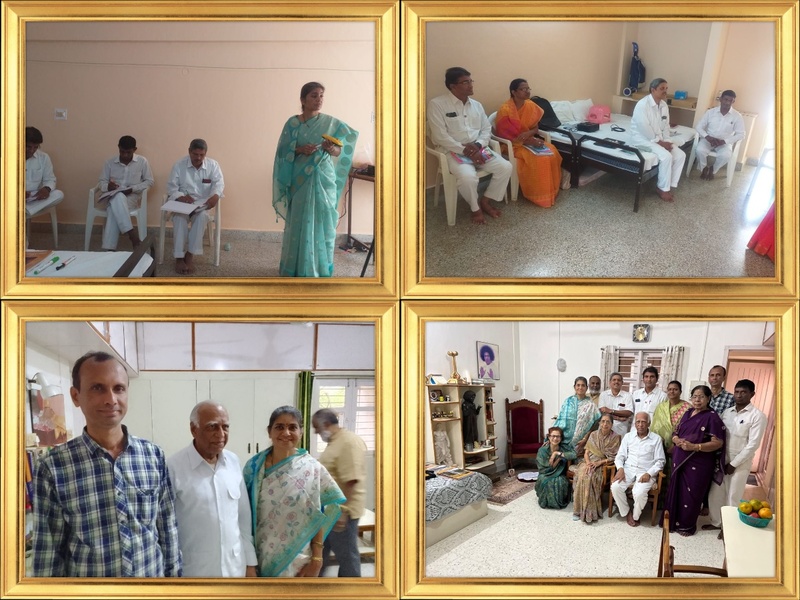
3. Camps and clinics
1. Various camps at new venues in India
Several practitioners during the holy month of November came forward to conduct camps at new venues as a commemorative to Swami’s 97th Birthday. 24 practitioners including 5 APs conducted camps at 20 venues spread across 9 states of Delhi, Haryana, Uttar Pradesh, Uttarakhand, Rajasthan, West Bengal, Odisha, Andhra Pradesh and Telangana. A total of 1049 patients were treated for various conditions. 434 IBs were also distributed. Venues included a college, schools, community centres, places of worship, and Sai centres, some in remote villages.
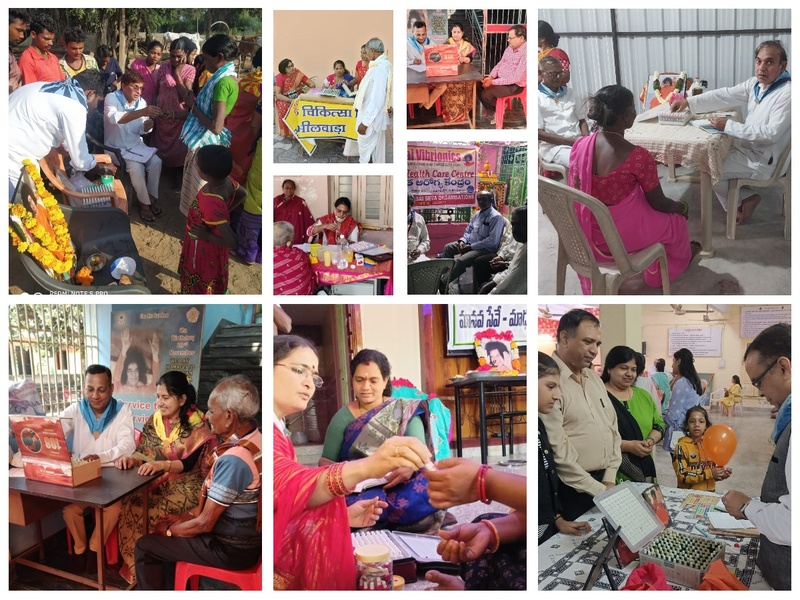
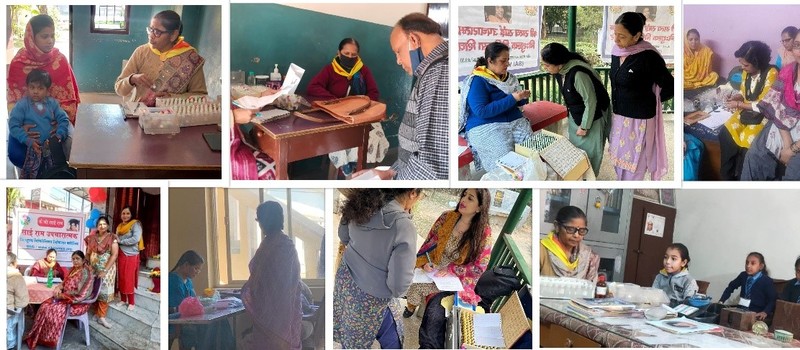
2. Annual camp at Puttaparthi Railway station
21 November 2022 saw the start of vibrionics annual camp at Puttaparthi railway station (see pic). It was organised by Practitioner 01228 for the 14th year running. She was supported by an international team of four practitioners from Japan, India and Canada. They served 541 patients over two and a half days. In addition to new ones, there were many returning patients who took remedies for family and friends. They mentioned these remedies were effective and often fast-acting; some were impressed with the “magical healing power” of these remedies. At times of difficulty in communication, they managed by way of hand signals and prayers! One practitioner brought laminated ‘precautions’ in English, Telugu and Hindi; this proved to be very helpful as patients could take pics for their future use. After seeing the photo of Swami placing His blessing hand on the 108CC Box, some were keen to spread the word!
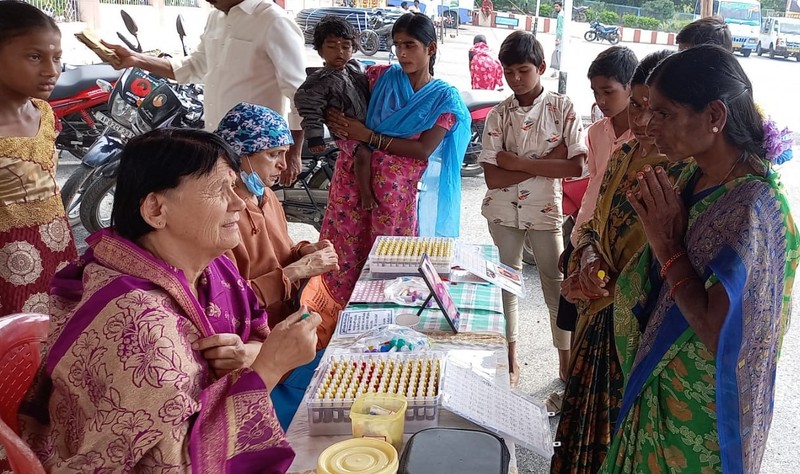
3. A new weekly Vibrionics Clinic in Hyderabad
It is heart-warming that a patient of Practitioner11632 impressed with the treatment she received, offered a room in her house in Hyderabad for a permanent weekly vibrionics clinic. The inauguration took place on 17 Dec 2022 (see pic) with introductory talks given by Vibrionics Teacher11567 and Director of Education10375. Medical Distribution of IBs took place at the time of the inauguration and the clinic is now running every Sunday morning 10 to 12 under Practitioner11632 with the support of several local practitioners.

4. A new fortnightly Vibrionics clinic in Visakhapatnam
Inauguration of Sai Vibrionics medical clinic at Sathya Sai Mandir, Chittavalasa, Vizag on 22 Dec 2022: The program started with bhajan followed by an introductory lecture on the importance of and need for Sai Vibrionics by vibrionics teacher and SVP 11567 with an interactive question and answer session. Convener of the mandir Sri Satyanarayana also emphasized that this holistic healing system is completely devoid of side effects, to the gathering of Sai youths and other devotees. A total of 75 immunity boosters were distributed. The clinic would be run every 2nd and 4th Sunday mornings from 10-12 by AP 18007, the first regular clinic was held on Christmas day.
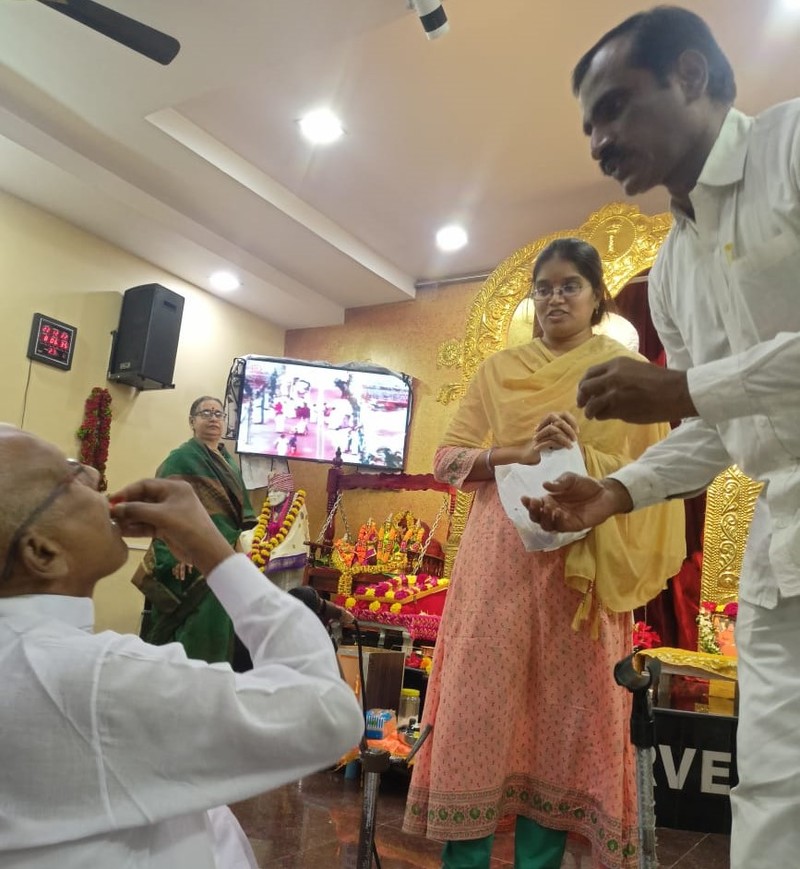
4. Sai Vibrionics presentation at the International Conference hosted by Heartfulness Institute 16-18 Dec 2022 10375, 11567
This Conference An Integrative Approach to Health and Wellbeing: Inspire, Innovate, Integrate was held in Hyderabad; participants hailed from all over the globe, most notably USA, UK, Romania, Malaysia, and Kuwait among other nations. The conference offered various tools and techniques to enhance personal well-being and research skills, and also provided a valuable opportunity for participants to become acquainted with other healing techniques. It also served as a platform for experts to share important, recent, and upcoming integrative approaches and innovations. Authors and researchers had been invited to submit abstracts for consideration. Sai Vibrionics chose to present a poster designed by Vibrionics teacher 11567, under the guidance of the founder Dr Aggarwal and the head of Education 10375 titled “Sai Vibrionics – an innovative, inspiring and integrated system of alternative healing”.
During the conference, the presenters explained the concept, importance, need, advantages and role of Sai Vibrionics both in preventing and treating various diseases. They demonstrated the use of the 108CC box and the SRHVP machine and cards. Vibrionics pamphlets were distributed and remedies were made for many interested patients. The two organizing practitioners were supported and assisted by several local practitioners 11568, 11612, 11618, 11626 & 11632. The presentation created a huge interest and visitors were highly appreciative of the service being provided. We are happy this will augment the growth of Vibrionics.
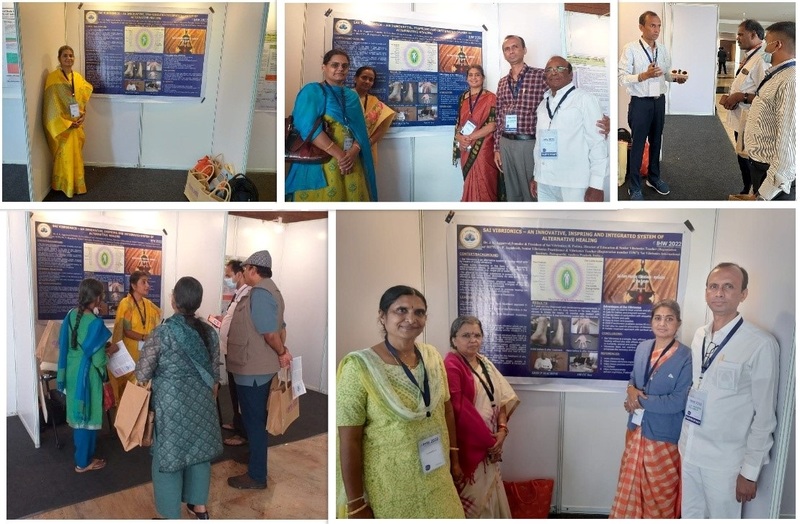
5. Anecdote
Painless despite radiation treatment post thyroid-removal 11632…India
A 45-year-old female underwent surgery for the removal of her cancer-riddled thyroid. Facing 30 radiation treatments over the next six weeks from 1 Sept to 15 Oct 2022, with expected severe pain, was quite an ordeal! She turned to vibrionics for help and was given the pain remedy in one litre of water to be sipped all day, and 6TD thereafter.
After five weeks of radiation the skin at the site of surgery opened up, but graciously without the burning sensation, severe pain and saline drip, all usually expected in such conditions. Thanks to the vibrionics remedies, she was even able to eat food throughout the treatment! Her doctor recommended taking a break during the radiation, but she continued non-stop!
At present she is completely normal, daily taking the necessary thyroxin hormone tablet. She firmly believes that vibrionics helped her go through the entire treatment rather painlessly. To express her gratitude, she has provided a room in her home for a weekly Vibrionics Clinic.
